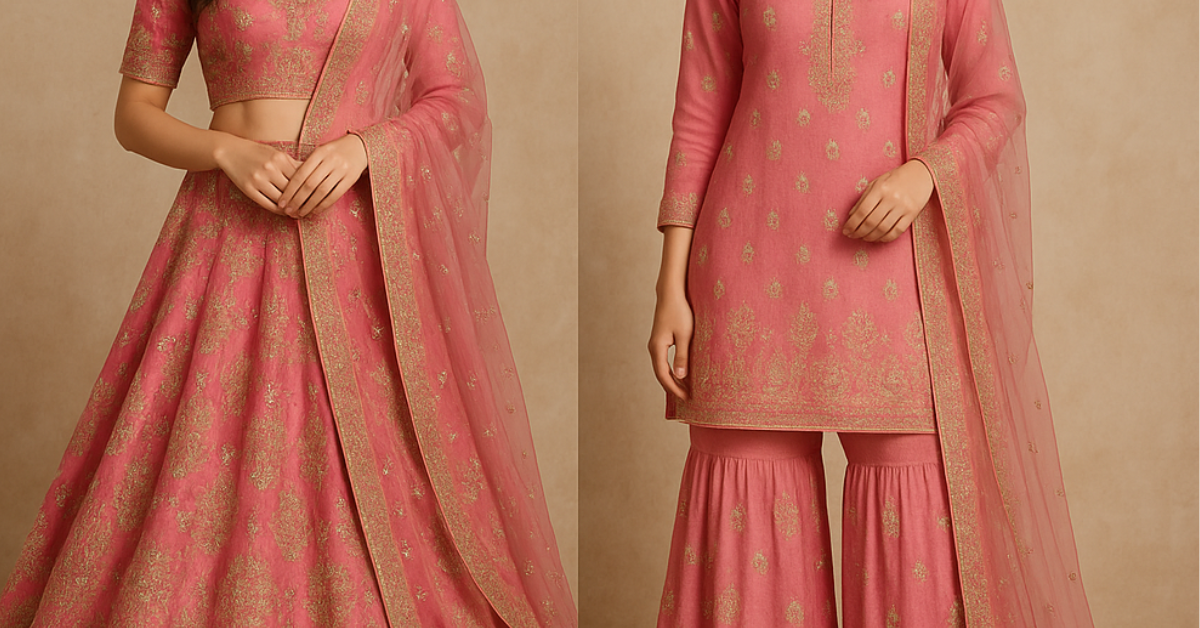In the vibrant world of South Asian fashion, two traditional outfits stand out for their elegance and cultural significance: the lehenga and the gharara. While these garments may appear similar at first glance, they each possess unique characteristics that set them apart. As we look ahead to 2025 fashion trends, understanding the distinctions between lehengas and ghararas becomes crucial for those who appreciate the rich tapestry of South Asian attire.
Origin and Cultural Significance
Lehenga
- Originated in the Mughal era
- Associated with royal and aristocratic fashion
- Widely popular across various regions of India
Gharara
- Originated in the Awadh region (present-day Lucknow)
- Traditionally associated with Muslim women in South Asia
- Popular in regions like Uttar Pradesh and Hyderabad
Design and Structure
Lehenga
- Consists of three pieces: a long skirt (lehenga), a blouse (choli), and a scarf (dupatta)
- The skirt is fully flared from the waist down
- Can be circular, paneled, or A-line in shape
Gharara
- Also consists of three pieces: wide-legged pants, a kurti (top), and a dupatta
- Distinctive feature: fitted from the waist to the knees, with a flare beginning at the knees
- A thick band or ruching at the knees creates the characteristic flare
Fabric and Embellishments
Lehenga
- Often made from luxurious fabrics like silk, velvet, or brocade
- Heavy embroidery, sequins, and stonework are common
- Designs can range from intricate traditional patterns to modern, minimalist styles
Gharara
- Traditionally made from lighter fabrics like cotton, georgette, or chiffon
- Embellishments are usually concentrated on the lower part of the pants and the hem
- Often features gota work, zari, or delicate embroidery
Occasion and Wear
Lehenga
- Primarily worn for weddings and formal occasions
- Considered a staple in bridal wear chose one of top Pakistani bridal wear designers
- Available in various styles suitable for different events, from sangeet to reception
Gharara
- Versatile outfit suitable for both formal and semi-formal occasions
- Popular choice for Eid celebrations and other festive events
- Can be styled for everyday wear in more casual fabrics and designs
Modern Interpretations and Trends
As we look, both lehengas and ghararas are experiencing exciting evolutions in design and styling:
Lehenga Trends
- Fusion designs incorporating Western elements like capes or jackets
- Sustainable and eco-friendly fabrics gaining popularity
- Minimalist lehengas with subtle embellishments for a contemporary look
Gharara Trends
- Revival of traditional gharara styles with modern twists
- Incorporation of bold prints and unconventional color combinations
- Lightweight, breathable fabrics for increased comfort and wearability
Styling Tips
Lehenga Styling
- Experiment with different blouse designs, from off-shoulder to high-neck styles
- Try innovative dupatta draping techniques for a unique look
- Accessorize with statement jewelry pieces that complement the outfit’s embellishments
Gharara Styling
- Pair with both short and long kurtis for versatile looks
- Experiment with asymmetrical hemlines or layered tops
- Opt for delicate jewelry to balance the outfit’s flowing silhouette
Comfort and Functionality
Lehenga
- Can be heavy due to extensive embroidery and fabric volume
- May require assistance for proper draping and movement
- Offers a regal and grand appearance
Gharara
- Generally more comfortable for movement and dancing
- Easier to manage independently
- Provides a balance between elegance and practicality
Conclusion
While both lehengas and ghararas are cherished elements of South Asian fashion, they each offer unique attributes that cater to different preferences and occasions. The lehenga, with its royal heritage and elaborate designs, continues to be a favorite for grand celebrations and weddings. On the other hand, the gharara, with its distinctive structure and versatility, provides a perfect blend of tradition and comfort suitable for various events.
As we approach, both these garments are evolving to meet contemporary tastes while maintaining their cultural essence. Whether you choose the sweeping elegance of a lehenga or the graceful flow of a gharara, both options offer a beautiful way to celebrate South Asian heritage and style.
FAQs
Can lehengas and ghararas be worn interchangeably?
While both are traditional outfits, they are typically worn for different occasions. Lehengas are more formal and often reserved for weddings, while ghararas can be styled for both formal and semi-formal events.
Are ghararas more comfortable than lehengas?
Generally, ghararas are considered more comfortable for movement due to their pant-like structure, but comfort can vary based on the specific design and fabric of each garment.
Can I wear a lehenga or gharara for everyday use?
While traditionally reserved for special occasions, modern interpretations of both garments, especially ghararas, can be styled for everyday wear using lighter fabrics and simpler designs.
How do I choose between a lehenga and a gharara for a wedding?
Consider the formality of the event, your role in the wedding, and personal comfort. Lehengas are often chosen for more formal wedding functions, while ghararas can be great for pre-wedding events or as a unique bridal outfit choice.
Are there any specific accessories that go better with lehengas or ghararas?
Both outfits pair well with traditional jewelry, but lehengas often accommodate heavier, more elaborate pieces, while ghararas look beautiful with more delicate, flowing jewelry styles.
How fashion trends influencing lehenga and gharara designs?
Trends are moving towards sustainable fabrics, fusion designs, and versatile pieces that can be styled multiple ways. Both lehengas and ghararas are being reimagined with modern silhouettes and innovative embellishment techniques.
